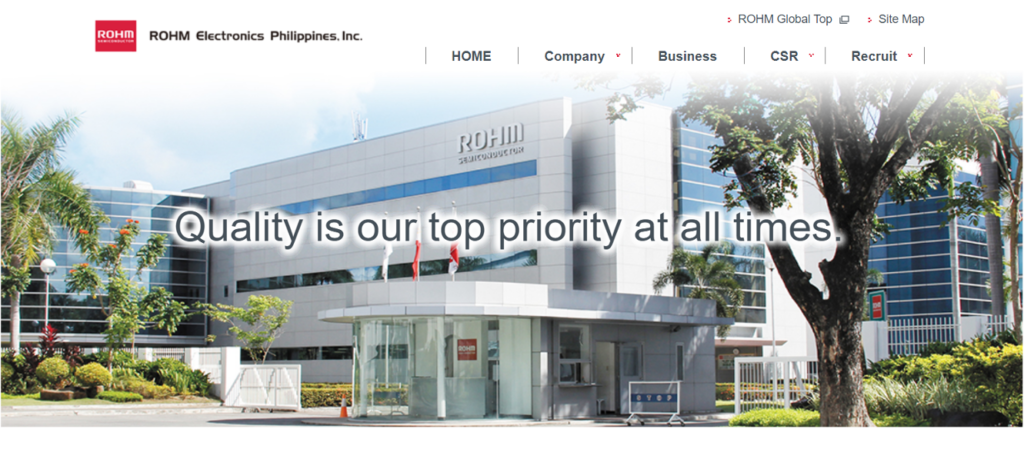Manual monitoring on process of material analysis transformed to system operation and made visualization on performance data
Provided to ROHM Electronics Philippines, Inc.

Corporate Profile
| Name of Company | ROHM Electronics Philippines, Inc. |
|---|---|
| Date of Establishment | September 1 - 1989 |
| Employees in Philippines | 4,906 as of March 2023 |
| Consolidated Revenue | More than 35 Billion US Dollars as of 2022 |
| Primary Products | ICs, Sensors, Transistors, Diodes, Print Heads, Resistors |
ISSUES AND CONCERN
When defects occur in the product delivered to their clients, they are collected at their department for the purpose of identifying the cause and preparing an analysis report. However, the current operational methods and management system are inefficient, making data collection issuing. As a result, they are unable to devise improvement measures at working process. Specific examples of issues include the following:- Due to operating in a 24-hour 3-shift system, there is a time-consuming handover process, leading to communication errors.
- Administrators have to check and aggregate various files to grasp the progress status, resulting in inefficiency.
- Performance metrics for each process are not quantified, and some parts of the report rely on subjective judgment.
- The inspection and analysis processes suffer from vague issues, making improvement difficult without sufficient data.
ACHIEVEMENT IN THIS PROJECT
As a result of implementing the development and introduction of a system to manage the analysis process in this project, the following achievements were obtained:
- Significantly improved efficiency by reducing the time required for handover in the 3-shift system and minimizing unnecessary workload caused by communication errors.
- The system was integrated into a large monitor in the office, enabling real-time comprehensive management of various analysis process.
- Visualization of lead times and analysis flows for each process allowed for accurate data understanding and assessment.
PROJECT OVERVIEW
When defects occur in the products sold to client companies worldwide, they are transported to their factory in the Philippines for analysis center. However, as this department was relatively new, it lacked digitalization capabilities. Consequently, we were tasked with proposing a solution to address urgent issues stemming from this weakness in digitalization. The request was to transition from manual processes to system management to achieve the resolution.
PROVIDED SERVICE
- Design, Development and Operation Support of Analysis Management System
PROJECT DETAIL
ROHM Electronics Philippines, Inc. is a wholly-owned subsidiary of ROHM Co., Ltd., headquartered in Kyoto. Established in 1989 as the Philippine branch, it boasts over 30 years of history as a leading manufacturer of semiconductor and electronic components. Notably, ROHM Electronics Philippines, Inc. serves as one of the key overseas branches, providing comprehensive services from manufacturing to sales.
The current request involves providing digitalization support for the operational processes received from the department responsible for analyzing product defects and conducting root cause identification.
【PHASE 01】 Understanding the Scope of Work
Given the high level of expertise required in our clients’ operations, initial step was to grasp their business content and fundamental knowledge. We conducted interviews primarily with the administrators to gain insights. In particular, we thoroughly examined each analysis process where the issues were evident in this project, following the 5W1H (What, Who, Where, When, Why, and How) approach to understand the current situation in detail. Additionally, they regularly create and send reports to the Japan headquarters summarizing the analysis status of each product.
【PHASE 02】 Identifying Challenges and Root Causes
The consultation on this matter involved two types of issues: “fully surfaced two specific issues” and “vaguely perceived multiple potential problems.” To address this, we conducted a thorough identification of the issues and root causes, including hypotheses. For the vaguely perceived issues, we requested our clients to jot down the reasons they felt like that and categorized the issues based on their relevance. Subsequently, we delved deeper into each challenge through a series of questions, iterating on hypotheses and validations. Additionally, their sales representatives in Japan lacked real-time access to the product analysis status, leading to challenges in providing prompt customer support.
【PHASE 03】 Establish Concept of System and Operational Flow
In this phase, we develop a conceptual plan for a system that aligns with the client company’s business processes and addresses each identified issues. Our focus is on outlining the overall structure of the system and defining the functional roles at a page level, rather than delving into detaile UI designs and features. We also assess the feasibility of implementing the system, considering factors such as the number of users, their level of digital literacy, and access methods compliant with internal regulations. Additionally, we collaborate with the system administrators at the Japan headquarters to explore options for API integration of analysis data and system customization capabilities.
【PHASE 04】 System Requirements and Interface Design
After completing the validation of the system’s conceptualization and operational flow, we proceeded with defining detailed system requirements and designing Interface elements. In this phase, we compiled all the functional and security requirements to be implemented in the system into documents and also carried out UI/UX design creation. By the end of this phase, we had a concrete visualization of the system’s structure, functionalities, and interfaces, allowing us to conduct a final validation in alignment with the operational flow.
【PHASE 05】 System Development and Delivery
Based on the system’s requirements specification and interface design, we proceeded with the development and debugging testing phase. During this period, they purchased necessary terminals, devices for the operation and explain how certain manual tasks would transition to system operation for their employees. Particularly, they shared the identified issues and the reasons for improvement with their employees through system operation, facilitating a relatively smooth implementation process. Following the system’s deployment, we monitored its performance for approximately six months and provided ongoing support for minor updates. Subsequently, we conducted two additional development to further enhance usability, which brings us to the current state of the system.
